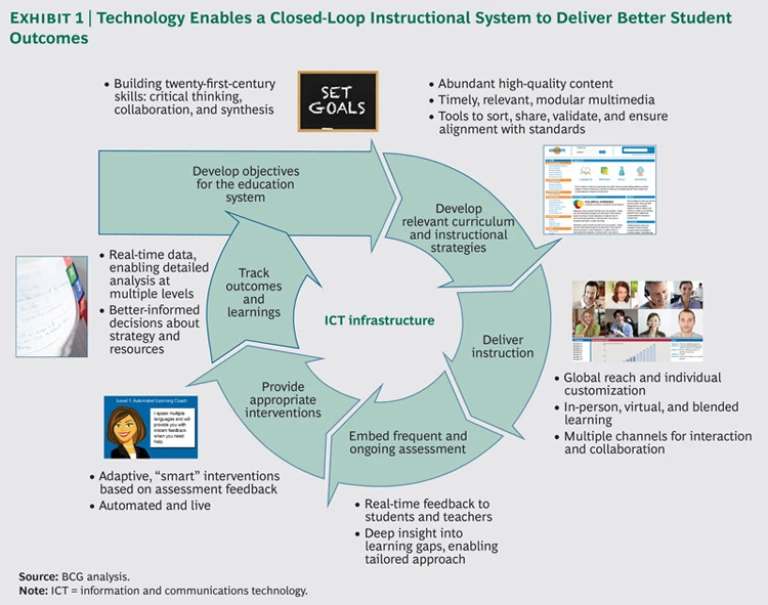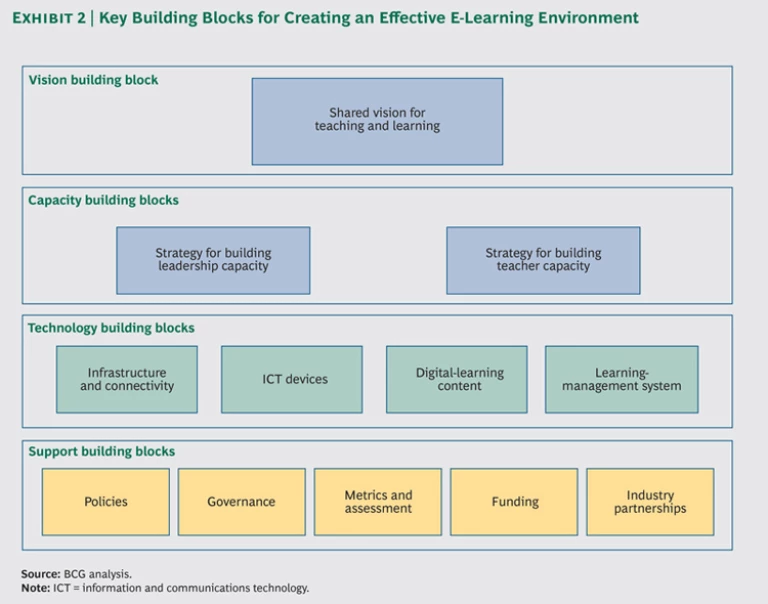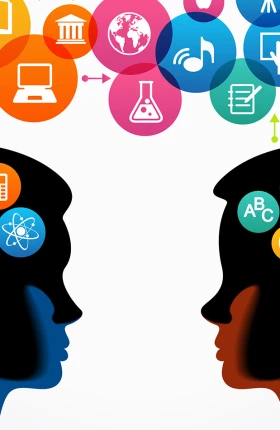In Riyadh Schools, a private K-12 school in Saudi Arabia, an eight-year-old girl calculates multiplication tables using an interactive program that feeds her increasingly difficult questions as she demonstrates higher levels of achievement. Across the hall, a ten-year-old boy prepares a short video explaining how automobile airbags work for his entry in the global 60 Second Science competition. In another room, a 12-year-old math student creates his own YouTube channel to help fellow students worldwide solve math problems.
The rich infrastructure of laptops, tablets, interactive white boards, collaborative software, and multimedia technologies makes it hard to believe that just one year earlier these classmates relied solely upon pencils, textbooks, and teacher lectures.
Classrooms around the world are rapidly evolving to keep pace with the technology revolution. Several educational initiatives have demonstrated extremely encouraging results in primary and secondary education, including Rocketship Education, School of One, and the Pearson-Knewton partnership.
While technology has enormous potential to transform the classroom experience, challenges exist when instituting effective e-learning models. The mere presence of computers and state-of-the-art learning-management systems will not improve student achievement. To create meaningful advances in educational outcomes, schools need to introduce technology strategically across the entire educational ecosystem.
We have seen very positive results when schools embrace a holistic approach to education through a closed-loop instructional system. (See Exhibit 1.) The closed-loop approach aligns educational objectives, standards, curricula, assessments, interventions, and professional development to enable continuous improvement in both instruction and student outcomes. (See Unleashing the Potential of Technology in Education , BCG report, August 2011.) The closed-loop instructional system has been used at Riyadh Schools with impressive results.
Riyadh Schools: One-to-One Teaching and Learning
BCG worked with Riyadh Schools to institute a comprehensive program of reform. As part of the program, the school established a digital educational model based on one-to-one teaching and learning. The children bring their own tablets and laptops to school, enabling unlimited opportunities to learn anytime, anywhere.
While such devices have laid the groundwork for transformative learning opportunities, introducing the technology itself was merely a starting point. The school’s leadership went on to provide intensive training to help teachers understand how new technologies could be used to expand and enhance their teaching and learning vision—a critical step in an environment where entrenched practices are sometimes difficult to change. In addition, a robust infrastructure was put in place to support these new technologies so that students and teachers alike could trust their connectivity to the Internet.
Although the program is still very new, it has already produced remarkable results in its first year: more than 30 percent of teachers have already begun using the technologies in highly advanced ways. In the first round of assessment, 95 percent of all teachers met the minimum standards for integration of technology into the classroom, and early adopters served as mentors for other teachers, thus functioning as catalysts for change.
For schools striving to integrate instructional technologies into the classroom, these early successes offer useful insights. We have identified four key building blocks that school systems must address in order to deliver better student outcomes with educational technology.
The Four Key Building Blocks
To achieve success in education, the technology revolution must be accompanied by a revolution of ideas on how to transform classrooms for teachers and students. This requires a holistic approach to change management in schools, composed of four building blocks. (See Exhibit 2.)
Create a shared vision for teaching and learning. The first building block of an effective e-learning environment is to create a shared vision among school leaders, teachers, students, and parents. All stakeholders must have a common understanding of what high-quality instruction looks like and how technology can help.
In Riyadh Schools, educators set the stage for the one-to-one program by gathering data and diagnostics on school achievement and assessing their students in light of international standards. This provided a baseline that allowed the school community to evaluate how students measured up and where there was room for improvement. Next, because school leaders already had a strong sense of the school’s mission, the evaluation was used as a starting point to build consensus. Educators asked, how can the school’s mission best be achieved in the context of information and communications technology (ICT)? This shared vision and mission—accompanied by clear standards and accountability—served as a touchstone for Riyadh Schools as it launched the one-to-one program.
Build leadership and teacher capacity. Once a shared vision for teaching and learning has been defined, school leaders must design a strategy to fulfill this vision. Ronald Lake, the director general of Riyadh Schools, says, “Once you introduce technology into teaching and learning, it gives you permission to make significant changes within the school. How teachers spend their time, the location of physical resources, how students work in teams—all of that is driven by the mission.” In Riyadh Schools, leadership coaches were brought in as advisors to the principals, vice principals, instructional leaders, and expert teachers. The coaches provided guidance on big-picture strategy—such as professional development, accountability, and tracking outcomes—and day-to-day challenges, such as managing attendance and cyber safety.
To build teacher capacity, Riyadh Schools established a series of professional-development opportunities. Early adopters were identified to serve as professional-development coaches. These instructional leaders held weekly workshops to discuss innovative ways of integrating technology into the curriculum. The school’s “teacher champions” led peer-to-peer mentoring programs to support less technologically engaged teachers as they honed their skills and pedagogical strategies.
The digitally empowered classroom cannot succeed without highly skilled teachers willing to reenvision their teaching and learning methodologies. That is not to say that teachers must fundamentally change their teaching and learning objectives, however. Rather, teachers are asked to envision new ways of meeting those objectives within a technology-rich environment.
Establish a robust technology infrastructure. A technology-rich environment will quickly lose its luster if teachers and students cannot trust their connections to the Internet or if they cannot effectively employ their new tools. To keep students and teachers engaged, schools must ensure the following:
- A robust and reliable core infrastructure with high-speed, wireless Internet connectivity
- Interoperable ICT devices
- Quality-assured, engaging digital-learning content
- A learning-management system that connects all teachers, students, and parents to high-quality educational resources and provides information about student learning and progress
Riyadh Schools established a unique, student-led mentoring program designed to help meet these goals. The program is being rolled out in three phases. In Phase I, technology-savvy students are trained to serve as frontline technical-support staff. At least two “geniuses,” as they are called, are assigned to each classroom to address any IT difficulties that arise. In Phase II, the students become pedagogical leaders in the classroom, helping teachers discover new technologies to achieve their learning objectives. In Phase III, the classroom leaders mentor younger students so they can develop the skills to enter the genius program. The school also employs technical staff to address systems management and IT challenges that cannot be handled by students. These layers of technical expertise allow teachers to stay focused on their teaching objectives while students expand their technical and leadership skills.
Develop supportive policies and partnerships. Schools must embrace supportive policies and partnerships to encourage widespread engagement internally, within the school community, as well as externally, with industry leaders in digital learning. These building blocks for support include the following:
- Policies on Internet usage, cyber safety, and digital citizenship
- Governance structure with rights and responsibilities related to the use of technology
- Metrics and assessments to measure outcomes
- Sources of long-term funding (at least three to five years)
- Industry partnerships with local suppliers
These powerful technologies and data systems require a significant investment up front. Riyadh Schools instituted a five-year plan, with capital renewal and routine maintenance as part of the package. This commitment at the outset helped to ensure that the school could be outfitted with world-class hardware and software. School leaders have also partnered with Microsoft and other companies to keep abreast of emerging technologies and stay on the cutting-edge of timely and relevant content in digital teaching and learning.
Lessons for Emerging Markets
While the field of educational technology is rife with ideas, the number of proven models with track records remains limited. Success depends on the ability of school systems to execute against a well-defined plan, stay the course, and learn from the inevitable setbacks and resistance to change.
Our work with Riyadh Schools has led us to identify several lessons for emerging markets. These lessons are particularly valuable for educational leaders who want to build scalable educational models that can be implemented across large school systems.
- Select the first wave of schools carefully. Identify the first cohort of schools with the capacity to deliver successful outcomes. Look for committed school leadership, capable ICT staff, ICT champion teachers, and a robust system architecture.
- Move as swiftly as you can. Ensure that implementation of the educational technology strategy is completed within two years. Beyond that, the project will lose momentum, community support will falter, and advances in technology may outpace your development speed.
- Put adequate infrastructure in place. Many systems falter or fail when schools do not have the capacity to support a large number of devices. When devices are left idle, teachers and students become disengaged.
- Deploy teaching and learning coaches as well as technical support in schools. Train and deploy coaches in each school to work with teachers to integrate technology into teaching and learning, and provide in-house support to solve technical issues on the spot. This support helps teachers develop trust in the devices as enhancements, rather than hindrances, to learning.
- Engage, engage, engage. Communicate regularly to build support and buy-in among teachers, students, parents, and other stakeholders. It is important to create a voice for each stakeholder through advisory panels and focus groups.
- Never back down on accountability. Ensure that accountable and quantifiable metrics are in place to track the achievements and progress of administrators, school leaders, teachers, and students.
- Ensure online safety. Develop and communicate the rules of engagement regarding Internet usage, cyber safety, and digital citizenship for all stakeholders from the outset.
- Stay agile. ICT in schools needs continuous review and updates because technology evolves rapidly. A maintenance-only approach is insufficient.
A thoughtful introduction of information technology into the classroom could revolutionize the way students communicate, collaborate, and create. Ronald Lake sums it up this way: “Is ICT a big enough lever to change education? By itself, no. It must be combined with bigger, systemwide changes in teaching and learning.” Our four building blocks, along with lessons learned, offer a roadmap to help schools deliver significant improvement in twenty-first-century teaching and learning.










